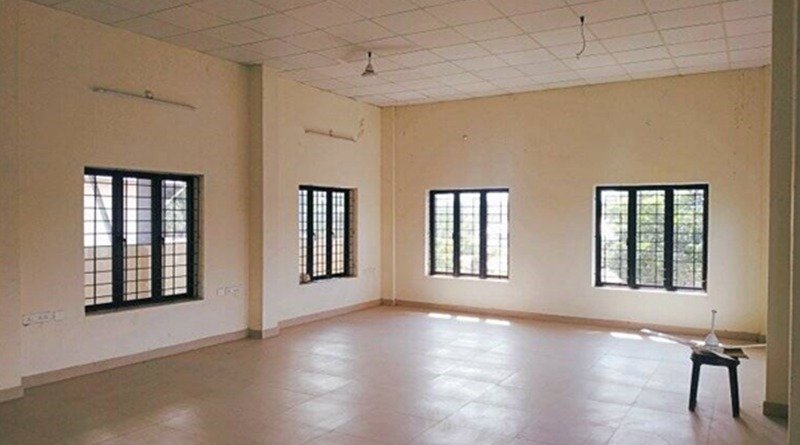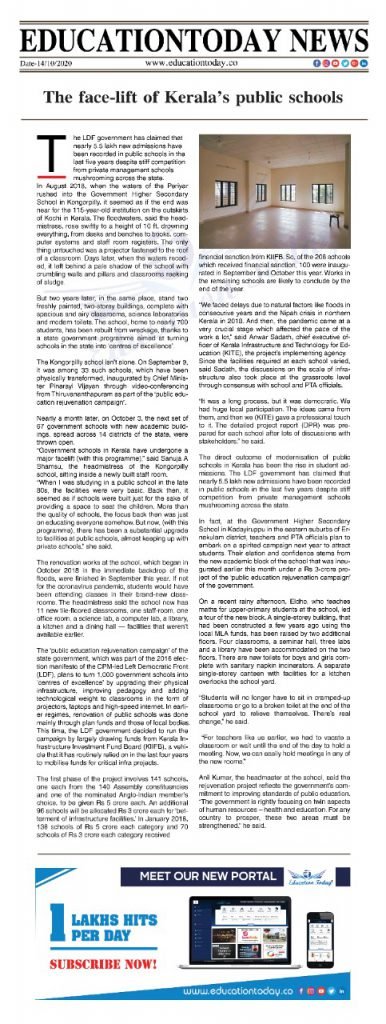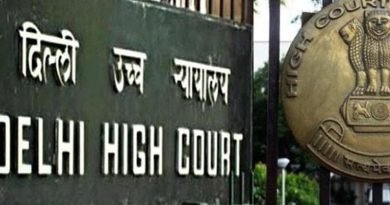The face-lift of Kerala’s public schools
The LDF government has claimed that nearly 5.5 lakh new admissions have been recorded in public schools in the last five years despite stiff competition from private management schools mushrooming across the state.

In August 2018, when the waters of the Periyar rushed into the Government Higher Secondary School in Kongorpilly, it seemed as if the end was near for the 115-year-old institution on the outskirts of Kochi in Kerala. The floodwaters, said the headmistress, rose swiftly to a height of 10 ft, drowning everything, from desks and benches to books, computer systems and staff room registers. The only thing untouched was a projector fastened to the roof of a classroom. Days later, when the waters receded, it left behind a pale shadow of the school with crumbling walls and pillars and classrooms reeking of sludge.
But two years later, in the same place, stand two freshly painted, two-storey buildings, complete with spacious and airy classrooms, science laboratories and modern toilets. The school, home to nearly 700 students, has been rebuilt from wreckage, thanks to a state government programme aimed at turning schools in the state into ‘centres of excellence’.
The Kongorpilly school isn’t alone. On September 9, it was among 33 such schools, which have been physically transformed, inaugurated by Chief Minister Pinarayi Vijayan through video-conferencing from Thiruvananthapuram as part of the ‘public education rejuvenation campaign’.
Nearly a month later, on October 3, the next set of 67 government schools with new academic buildings, spread across 14 districts of the state, were thrown open.
“Government schools in Kerala have undergone a major facelift (with this programme),” said Sanuja A Shamsu, the headmistress of the Kongorpilly school, sitting inside a newly built staff room.
“When I was studying in a public school in the late 80s, the facilities were very basic. Back then, it seemed as if schools were built just for the sake of providing a space to seat the children. More than the quality of schools, the focus back then was just on educating everyone somehow. But now, (with this programme), there has been a substantial upgrade to facilities at public schools, almost keeping up with private schools,” she said.
The renovation works at the school, which began in October 2018 in the immediate backdrop of the floods, were finished in September this year. If not for the coronavirus pandemic, students would have been attending classes in their brand-new classrooms. The headmistress said the school now has 11 new tile-floored classrooms, one staff-room, one office room, a science lab, a computer lab, a library, a kitchen and a dining hall — facilities that weren’t available earlier.
The ‘public education rejuvenation campaign’ of the state government, which was part of the 2016 election manifesto of the CPM-led Left Democratic Front (LDF), plans to turn 1,000 government schools into ‘centres of excellence’ by upgrading their physical infrastructure, improving pedagogy and adding technological weight to classrooms in the form of projectors, laptops and high-speed internet. In earlier regimes, renovation of public schools was done mainly through plan funds and those of local bodies.
This time, the LDF government decided to run the campaign by largely drawing funds from Kerala Infrastructure Investment Fund Board (KIIFB), a vehicle that it has routinely relied on in the last four years to mobilise funds for critical infra projects.
The first phase of the project involves 141 schools, one each from the 140 Assembly constituencies and one of the nominated Anglo-Indian member’s choice, to be given Rs 5 crore each. An additional 96 schools will be allocated Rs 3 crore each for ‘betterment of infrastructure facilities.’ In January 2018, 138 schools of Rs 5 crore each category and 70 schools of Rs 3 crore each category received financial sanction from KIIFB. So, of the 208 schools which received financial sanction, 100 were inaugurated in September and October this year. Works in the remaining schools are likely to conclude by the end of the year.
“We faced delays due to natural factors like floods in consecutive years and the Nipah crisis in northern Kerala in 2018. And then, the pandemic came at a very crucial stage which affected the pace of the work a lot,” said Anwar Sadath, chief executive officer of Kerala Infrastructure and Technology for Education (KITE), the project’s implementing agency.
Since the facilities required at each school varied, said Sadath, the discussions on the scale of infrastructure also took place at the grassroots level through consensus with school and PTA officials.
“It was a long process, but it was democratic. We had huge local participation. The ideas came from them, and then we (KITE) gave a professional touch to it. The detailed project report (DPR) was prepared for each school after lots of discussions with stakeholders,” he said.
The direct outcome of modernisation of public schools in Kerala has been the rise in student admissions. The LDF government has claimed that nearly 5.5 lakh new admissions have been recorded in public schools in the last five years despite stiff competition from private management schools mushrooming across the state.
In fact, at the Government Higher Secondary School in Kadayiruppu in the eastern suburbs of Ernakulam district, teachers and PTA officials plan to embark on a spirited campaign next year to attract students. Their elation and confidence stems from the new academic block of the school that was inaugurated earlier this month under a Rs 3-crore project of the ‘public education rejuvenation campaign’ of the government.
On a recent rainy afternoon, Eldho, who teaches maths for upper-primary students at the school, led a tour of the new block. A single-storey building, that had been constructed a few years ago using the local MLA funds, has been raised by two additional floors. Four classrooms, a seminar hall, three labs and a library have been accommodated on the two floors. There are new toilets for boys and girls complete with sanitary napkin incinerators. A separate single-storey canteen with facilities for a kitchen overlooks the school yard.
“Students will no longer have to sit in cramped-up classrooms or go to a broken toilet at the end of the school yard to relieve themselves. There’s real change,” he said.
“For teachers like us earlier, we had to vacate a classroom or wait until the end of the day to hold a meeting. Now, we can easily hold meetings in any of the new rooms.”
Anil Kumar, the headmaster at the school, said the rejuvenation project reflects the government’s commitment to improving standards of public education. “The government is rightly focusing on twin aspects of human resources – health and education. For any country to prosper, these two areas must be strengthened,” he said.
The face-lift of Kerala’s public schools

315,212 total views



